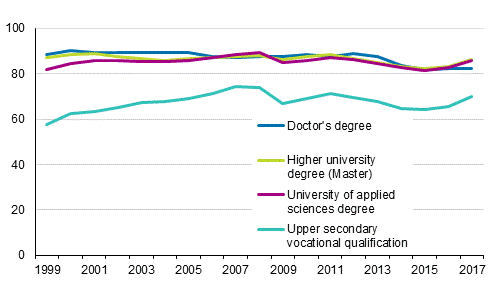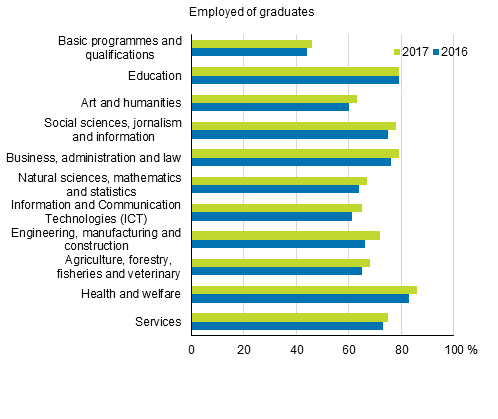Published: 24 January 2019
Employment of recent graduates improved
According to Statistics Finland's Education Statistics, employment of recent graduates improved by four percentage points in 2017 compared with one year earlier. Almost 70 per cent were employed one year after graduation. The employment of graduates with upper secondary vocational education improved most, by five percentage points. Of them, 70 per cent were employed. Altogether 86 per cent of those with university of applied sciences degrees and higher university degrees were employed. Eighty-three per cent of those with a doctorate degree were employed.
Employment of graduates one year after graduation 1999–2017, %

Employment among recent graduates is measured one year after their graduation. One year after graduation, 70 per cent of the graduates were employed, of whom 55 per cent were working full-time and 15 per cent were working beside studies. The share of those working full-time increased by four percentage points. The proportion of the unemployed was 10 per cent.
Employment improved most in the male-dominated field of technology
There were differences in the transition to working life by field of education. Employment improved most in the male-dominated field of technology, by six percentage points. In 2017, altogether 72 per cent of those who graduated from the field of technology were employed. Employment increased second most in the field of information and communication technology (ICT), by four percentage points. Despite this, the share of unemployed was still highest in the field of ICT, 15 per cent. The transition was easiest for graduates with qualifications from the female-dominated field of health and welfare, of which 86 per cent of graduates were employed. Altogether 79 per cent in the fields of education and business, administration and law were employed.
Employment of graduates one year after graduation by field of education 2016–2017, %

In 2017, the difference between the employment rates of recently graduated women and men narrowed by 1.5 percentage points compared to the previous year. In all, 73 per cent of all recently graduated women and 65 per cent of men were working. Seventy per cent of those with qualifications from upper secondary vocational education were employed, 74 per cent of women and 65 per cent of men. Of those with a qualification from upper secondary vocational education, 15 per cent were unemployed, 12 per cent of women and 18 per cent of men. Ten years earlier, the share of unemployed among the attainers of an upper secondary vocational qualification was nine per cent.
Altogether, 86 per cent of those with university of applied sciences degrees and higher university degrees were employed one year after graduation. Women and men with university degrees found employment almost equally easily. Seven per cent of those with a qualification from universities of applied sciences and six per cent of those with higher university degrees were unemployed. Ninety-five per cent of those with a higher university of applied sciences degree were working one year after graduation and three per cent were unemployed. Of recently graduated doctors, 83 per cent were employed and seven per cent were unemployed.
The majority of those having passed the matriculation examination continued studies one year later, although only 28 per cent immediately continued studies in the same year, see Entrance to education . One year after the matriculation examination, 55 per cent of passers of the matriculation examination continued studies leading to a qualification or degree, 60 per cent of women and 50 per cent of men. Every fifth was also working beside further studies. Twenty-six per cent of passers of the matriculation examination in the previous year were working full-time and six per cent were unemployed in 2017. Ten years earlier, the share of those who continued studies one year after graduation was ten percentage points higher, i.e. 65 per cent.
In most university education, the right to study is for a higher university degree. For that reason, the majority of recent graduates with lower university degrees continued studies (89 per cent), as many women as men. Over one-half were also working beside studies (56 per cent).
More detailed data on the employment of recent graduates by region of residence, age, level and field of education can be found in the database tables .
Source: Education 2019. Statistics Finland
Inquiries: Anna Loukkola 029 551 3678, koulutustilastot@stat.fi
Director in charge: Jari Tarkoma
Publication in pdf-format (222.2 kB)
- Tables
-
Tables in databases
Pick the data you need into tables, view the data as graphs, or download the data for your use.
Appendix tables
Updated 24.1.2019
Official Statistics of Finland (OSF):
Transition from school to further education and work [e-publication].
ISSN=1798-9469. 2017. Helsinki: Statistics Finland [referred: 21.12.2025].
Access method: http://stat.fi/til/sijk/2017/sijk_2017_2019-01-24_tie_001_en.html

